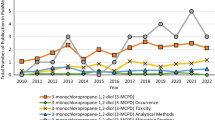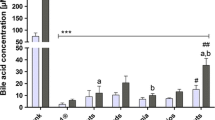Abstract
The food contaminants 3-chloro-1,2-propanediol (3-MCPD) and 3-MCPD fatty acid esters have attracted considerable attention in the past few years due to their toxic properties and their occurrence in numerous foods. Recently, significant amounts of the isomeric compounds 2-chloro-1,3-propanediol (2-MCPD) fatty acid esters have been detected in refined oils. Beside the interrogation which toxic effects might be related to the core compound 2-MCPD, the key question from the risk assessment perspective is again—as it was discussed for 3-MCPD fatty acid esters before—to which degree these esters are hydrolyzed in the gut, thereby releasing free 2-MCPD. Here, we show that free 2-MCPD but not 2-MCPD fatty acid esters were able to cross a monolayer of differentiated Caco-2 cells as an in vitro model for the human intestinal barrier. Instead, the esters were hydrolyzed by the cells, thereby releasing free 2-MCPD which was neither absorbed nor metabolized by the cells. Cytotoxicity assays revealed that free 2-MCPD as well as free 3-MCPD was not toxic to Caco-2 cells up to a level of 1 mM, whereas cellular viability was slightly decreased in the presence of a few 2-MCPD and 3-MCPD fatty acid esters at concentrations above 10 µM. The observed cytotoxic effects correlated well with the induction of caspase activity and might be attributed to the induction of apoptosis by free fatty acids which were released from the esters in the presence of Caco-2 cells.



Similar content being viewed by others
References
Abraham K, Appel KE, Berger-Preiss E et al (2013) Relative oral bioavailability of 3-MCPD from 3-MCPD fatty acid esters in rats. Arch Toxicol 87:649–659
Andres S, Appel KE, Lampen A (2013) Toxicology, occurrence and risk characterisation of the chloropropanols in food: 2-monochloro-1,3-propanediol, 1,3-dichloro-2-propanol and 2,3-dichloro-1-propanol. Food Chem Toxicol 58:467–478
Bakhiya N, Abraham K, Gurtler R, Appel KE, Lampen A (2011) Toxicological assessment of 3-chloropropane-1,2-diol and glycidol fatty acid esters in food. Mol Nutr Food Res 55:509–521
Buesen R, Mock M, Seidel A, Jacob J, Lampen A (2002) Interaction between metabolism and transport of benzo[a]pyrene and its metabolites in enterocytes. Toxicol Appl Pharmacol 183:168–178
Buhrke T, Weisshaar R, Lampen A (2011) Absorption and metabolism of the food contaminant 3-chloro-1,2-propanediol (3-MCPD) and its fatty acid esters by human intestinal Caco-2 cells. Arch Toxicol 85:1201–1208
Cho WS, Han BS, Lee H et al (2008a) Subchronic toxicity study of 3-monochloropropane-1,2-diol administered by drinking water to B6C3F1 mice. Food Chem Toxicol 46:1666–1673
Cho WS, Han BS, Nam KT et al (2008b) Carcinogenicity study of 3-monochloropropane-1,2-diol in Sprague-Dawley rats. Food Chem Toxicol 46:3172–3177
Cogburn JN, Donovan MG, Schasteen CS (1991) A model of human small intestinal absorptive cells. 1. Transport barrier. Pharm Res 8:210–216
Ebert B, Seidel A, Lampen A (2005) Identification of BCRP as transporter of benzo[a]pyrene conjugates metabolically formed in Caco-2 cells and its induction by Ah-receptor agonists. Carcinogenesis 26:1754–1763
EFSA scientific report (2011) Comparison between 3-MCPD and its palmitic esters in a 90-day toxicological study. http://www.efsa.europa.eu/en/supporting/doc/187e.pdf
Fauser JK, Matthews GM, Cummins AG, Howarth GS (2013) Induction of apoptosis by the medium-chain length fatty acid lauric acid in colon cancer cells due to induction of oxidative stress. Chemotherapy 59:214–224
Federal Institute for Risk Assessment (2007) BfR opinion 047/2007. Infant formula and follow-up formula may contain harmful 3-MCPD fatty acid esters. http://www.bfr.bund.de/cm/349/infant_formula_and_follow_up_formula_may_contain_harmful_3_mcpd_fatty_acid_esters.pdf
Giros A, Grzybowski M, Sohn VR et al (2009) Regulation of colorectal cancer cell apoptosis by the n-3 polyunsaturated fatty acids Docosahexaenoic and Eicosapentaenoic. Cancer Prev Res 2:732–742
Grosse Y, Baan R, Secretan-Lauby B et al (2011) Carcinogenicity of chemicals in industrial and consumer products, food contaminants and flavourings, and water chlorination byproducts. Lancet Oncol 12:328–329
Kuhlmann J (2011) Determination of bound 2,3-epoxy-1-propanol (glycidol) and bound monochloropropanediol (MCPD) in refined oils. Eur J Lipid Sci Technol 113:335–344
Kusminski CM, Shetty S, Orci L, Unger RH, Scherer PE (2009) Diabetes and apoptosis: lipotoxicity. Apoptosis 14:1484–1495
Lynch BS, Bryant DW, Hook GJ, Nestmann ER, Munro IC (1998) Carcinogenicity of monochloro-1,2-propanediol (alpha-chlorohydrin, 3-MCPD). Int J Toxicol 17:47–76
Schilter B, Scholz G, Seefelder W (2011) Fatty acid esters of chloropropanols and related compounds in food: toxicological aspects. Eur J Lipid Sci Technol 113:309–313
Seefelder W, Varga N, Studer A, Williamson G, Scanlan FP, Stadler RH (2008) Esters of 3-chloro-1,2-propanediol (3-MCPD) in vegetable oils: significance in the formation of 3-MCPD. Food Addit Contam 25:391–400
Spalinger JH, Seidman EG, Menard D, Levy E (1998) Endogenous lipase activity in Caco-2 cells. Biochim Biophys Acta 1393:119–127
Sun J, Bai S, Bai W et al (2013) Toxic mechanisms of 3-monochloropropane-1,2-diol on progesterone production in R2C rat leydig cells. J Agr Food Chem 61:9955–9960
Unger RH, Orci L (2002) Lipoapoptosis: its mechanism and its diseases. Biochim Biophys Acta 1585:202–212
Zambo V, Simon-Szabo L, Szelenyi P, Kereszturi E, Banhegyi G, Csala M (2013) Lipotoxicity in the liver. J Hepatol 5:550–557
Acknowledgments
We thank Linda Brandenburger for helpful technical assistance. This work was funded by the Federal Institute for Risk Assessment (project number 1322-523).
Conflict of interest
The authors declare that they have no conflict of interest.
Author information
Authors and Affiliations
Corresponding author
Rights and permissions
About this article
Cite this article
Buhrke, T., Frenzel, F., Kuhlmann, J. et al. 2-Chloro-1,3-propanediol (2-MCPD) and its fatty acid esters: cytotoxicity, metabolism, and transport by human intestinal Caco-2 cells. Arch Toxicol 89, 2243–2251 (2015). https://doi.org/10.1007/s00204-014-1395-3
Received:
Accepted:
Published:
Issue Date:
DOI: https://doi.org/10.1007/s00204-014-1395-3




